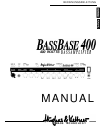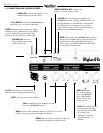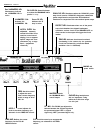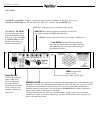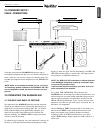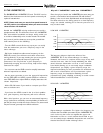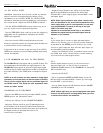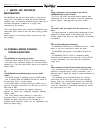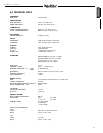
BASSBASE
400
-
MANUAL
3.2 THE VARIMETRIC
EQ
Why call if "VARIMETRIC" rather than “PARAMETRIC?”
The
BASSBASE
400 VARIMETRIC EQ and FX LOOP can be
switched via the buttons on the front panel or remotely via
optional footswitches.
NOTE: Please make sure you set the front panel buttons fo
the OFF position (not depressed) when you want to activate
these functions via footswitch.
Even though you handle the VARIMETRIC the same way you
would a conventional semi-parametric EQ with its fixed
filtering, it is a much more sophisticated sound-shaping tool.
The filters, rather than the being geared to a fixed frequency
range, are variable, enabling you to fine-tune your tone for a
truly musical result.
Handle the VARIMETRIC voicing sections as you would a
semiparametric EQ. The difference lies in the VARIMETRIC
EQ's auto-variable bandwidth and slope, which enable you
to achieve substantially more musical results. The easiest
way to use it (and the best way to acquaint yourself with
how it works) is to do the following:
LOW/MID VARIMETRIC
-
Turn the LEVEL control all the way up so you can really
hear the results when you tune a frequency range in the
lower midrange.
20 dB
10 dB
0 dB
-10 dB
-20 dB
80
Hz
160Hz
250 Hz
400 Hz 560 Hz 800 Hz
1
kHz
-
Dial in the desired low-mids center frequency via the
FREQ HZ control. (You will hear a wah-wah effect when
turning this knob). If you stop rotating the pot at any point
you will hear that particular frequency especially
pronounced. You may find that a given frequency is
particularly annoying, but not to worry, help is near: simply
attenuate the culprit.
-
You can now use the LEVEL control to amplify/attenuate
selected frequencies as desired.
-
Use the same procedure to tune the upper-mid frequencies
via the FREQ KHZ and LEVEL controls (LEVEL to maximum,
tune FREQ KHZ, then adjust LEVEL to amplify/attenuate the
chosen frequencies.
This frequency diagram depicts the effects of the
VARIMETRIC EQ on the lower-midrange. As clearly
illustrated, the boost of a complete octave range is very
well-
rounded and even, ideal for clearly establishing the basic
sound character. Attenuation occurs at a much narrower
band width allowing you to accurately target undesirable
frequencies. If you amplify a given frequency range, the
frequencies bordering its outer parameters are smoothed out
with a touch of attenuation, and if you attenuate a given
frequency range, the frequencies bordering its outer
parameters are gently amplified, achieving an audio contour
which intensifies the
overall
EQ effect.
HIGH/MID VARIMETRIC
-
Hit the EQ ON button if you need to compare your
EQed
tone to the basic tone.
-
If you leave the LEVEL control in the 12 o’clock position
for a given frequency, that frequency will not be affected.
With a bit of practice, you can tune an attenuated frequency
range (rather than artificially overemphasizing it first like we
just did), but keep in mind that for the human ear, attenuated
frequencies are generally more diffult to discern.
20 dB
10 dB
0 dB
-10 dB
-20 dB
-
0.5
kHz
0,85
kHz
2,5
kHz
4
kHz
6,5
kHz
10
kHz
15
kHz
Higher-midrange equalization: The higher the frequency, the
broader the bandwidth processed by the VARIMETRIC EQ,
much in the way the human ear registers the upper end.
Attenuation occurs at a much narrower band width so you
can accurately target undesirable frequencies and avoid the
dreaded broad-band hollow midrange effect.



